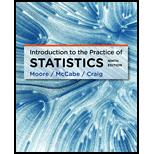
Concept explainers
(a)
To find: The predicted values and residuals for each of the four regression equation.
(a)
Answer to Problem 112E
Solution: The predicted values and residuals for Data set A is given below:
Predicted values |
Residual |
||
10 |
8.04 |
8.001 |
0.039 |
8 |
6.95 |
7.001 |
|
13 |
7.58 |
9.501 |
|
9 |
8.81 |
7.501 |
1.309 |
11 |
8.33 |
8.501 |
|
14 |
9.96 |
10.001 |
|
6 |
7.24 |
6.001 |
1.239 |
4 |
4.26 |
5.000 |
|
12 |
10.84 |
9.001 |
1.839 |
7 |
4.82 |
6.501 |
|
5 |
5.68 |
5.501 |
0.179 |
The predicted values and residuals for Data set B is given below:
Predicted values |
Residual |
||
10 |
9.14 |
8.001 |
1.139 |
8 |
8.14 |
7.001 |
1.139 |
13 |
8.74 |
9.501 |
|
9 |
8.77 |
7.501 |
1.269 |
11 |
9.26 |
8.501 |
0.759 |
14 |
8.10 |
10.001 |
|
6 |
6.13 |
6.001 |
0.129 |
4 |
3.10 |
5.000 |
|
12 |
9.13 |
9.001 |
0.129 |
7 |
7.26 |
6.501 |
0.759 |
5 |
4.74 |
5.501 |
The predicted values and residuals for Data set C is given below:
Predicted values |
Residual |
||
10 |
7.46 |
7.999 |
|
8 |
6.77 |
7.000 |
|
13 |
12.74 |
9.499 |
3.241 |
9 |
7.11 |
7.50 |
|
11 |
7.81 |
8.499 |
|
14 |
8.84 |
9.999 |
|
6 |
6.08 |
6.001 |
0.079 |
4 |
5.39 |
5.001 |
0.389 |
12 |
8.15 |
8.999 |
|
7 |
6.42 |
6.501 |
|
5 |
5.73 |
5.501 |
0.229 |
The predicted values and residuals for Data set D is given below:
Predicted values |
Residual |
||
8 |
6.58 |
7.001 |
|
8 |
5.76 |
7.001 |
|
8 |
7.71 |
7.001 |
0.709 |
8 |
8.84 |
7.001 |
1.839 |
8 |
8.47 |
7.001 |
1.469 |
8 |
7.04 |
7.001 |
0.039 |
8 |
5.25 |
7.001 |
|
8 |
5.56 |
7.001 |
|
8 |
7.91 |
7.001 |
0.909 |
8 |
6.89 |
7.001 |
|
19 |
12.50 |
12.5 |
Explanation of Solution
Calculation: To predict y for Data set A, Minitab is used. The steps to be followed are:
Step 1: Go to the Minitab worksheet.
Step 2: Go to Stat > Regression > Regression.
Step 3: Enter the variable
Step 4: Go to results and select “The table of fits and residuals.”
Step 5: Click OK.
Hence, the result is
Predicted values |
Residual |
||
10 |
8.04 |
8.001 |
0.039 |
8 |
6.95 |
7.001 |
|
13 |
7.58 |
9.501 |
|
9 |
8.81 |
7.501 |
1.309 |
11 |
8.33 |
8.501 |
|
14 |
9.96 |
10.001 |
|
6 |
7.24 |
6.001 |
1.239 |
4 |
4.26 |
5.000 |
|
12 |
10.84 |
9.001 |
1.839 |
7 |
4.82 |
6.501 |
|
5 |
5.68 |
5.501 |
0.179 |
To predict y for Data set B, Minitab is used. The steps to be followed are:
Step 1: Go to the Minitab worksheet.
Step 2: Go to Stat > Regression > Regression.
Step 3: Enter the variable
Step 4: Go to results and select “The table of fits and residuals.”
Step 5: Click OK.
Hence, the result is
Predicted values |
Residual |
||
10 |
9.14 |
8.001 |
1.139 |
8 |
8.14 |
7.001 |
1.139 |
13 |
8.74 |
9.501 |
|
9 |
8.77 |
7.501 |
1.269 |
11 |
9.26 |
8.501 |
0.759 |
14 |
8.10 |
10.001 |
|
6 |
6.13 |
6.001 |
0.129 |
4 |
3.10 |
5.000 |
|
12 |
9.13 |
9.001 |
0.129 |
7 |
7.26 |
6.501 |
0.759 |
5 |
4.74 |
5.501 |
To predict y for Data set C, Minitab is used. The steps to be followed are:
Step 1: Go to the Minitab worksheet.
Step 2: Go to Stat > Regression > Regression.
Step 3: Enter the variable
Step 4: Go to results and select “The table of fits and residuals.”
Step 5: Click OK.
Hence, the result is
Predicted values |
Residual |
||
10 |
7.46 |
7.999 |
|
8 |
6.77 |
7.000 |
|
13 |
12.74 |
9.499 |
3.241 |
9 |
7.11 |
7.50 |
|
11 |
7.81 |
8.499 |
|
14 |
8.84 |
9.999 |
|
6 |
6.08 |
6.001 |
0.079 |
4 |
5.39 |
5.001 |
0.389 |
12 |
8.15 |
8.999 |
|
7 |
6.42 |
6.501 |
|
5 |
5.73 |
5.501 |
0.229 |
To predict y for Data set D, Minitab is used. The steps to be followed are:
Step 1: Go to the Minitab worksheet.
Step 2: Go to Stat > Regression > Regression.
Step 3: Enter the variable
Step 4: Go to results and select “The table of fits and residuals.”
Step 5: Click OK.
Hence, the result is
Predicted values |
Residual |
||
8 |
6.58 |
7.001 |
|
8 |
5.76 |
7.001 |
|
8 |
7.71 |
7.001 |
0.709 |
8 |
8.84 |
7.001 |
1.839 |
8 |
8.47 |
7.001 |
1.469 |
8 |
7.04 |
7.001 |
0.039 |
8 |
5.25 |
7.001 |
|
8 |
5.56 |
7.001 |
|
8 |
7.91 |
7.001 |
0.909 |
8 |
6.89 |
7.001 |
|
19 |
12.50 |
12.5 |
Interpretation: The residual values are the differences of observed value and the predicted value.
(b)
To graph: The residual versus x for each of the four datasets.
(b)
Explanation of Solution
Graph: To plot the residual versus x for each of the four datasets, Minitab is used. The steps to be followed are:
Step 1: Go to the Minitab worksheet.
Step 2: Go to Stat > Regression > Regression.
Step 3: Enter the variable
Step 4: Go to graph and select Residual versus fits.
Step 5: Click OK.
Hence, the obtained graph is
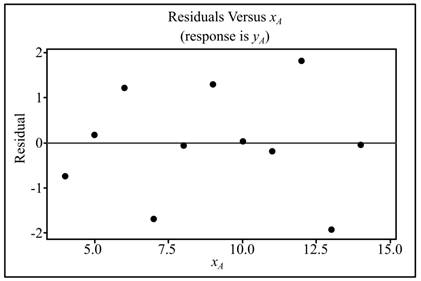
Similarly, repeat the steps for the residual plot versus x for Dataset B:
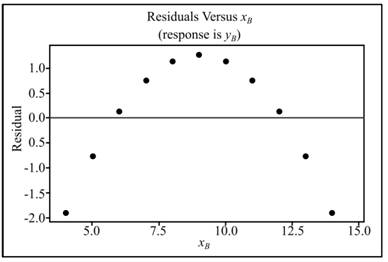
The residual plot versus x for Dataset C:
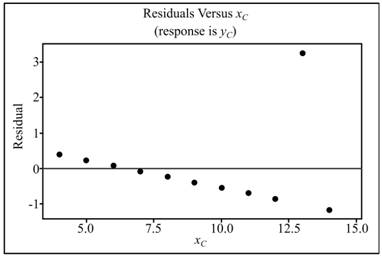
The residual plot versus x for Dataset D:
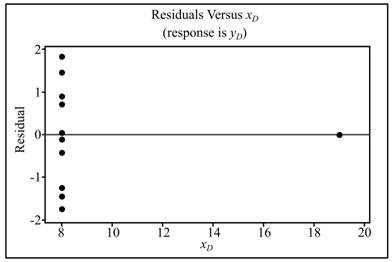
(c)
To explain: The summary for the residuals.
(c)
Answer to Problem 112E
Solution: The regression lines for datasets A and C fit the data quite well. The residual plot for dataset C shows strong
Explanation of Solution
Want to see more full solutions like this?
Chapter 2 Solutions
Introduction to the Practice of Statistics
 MATLAB: An Introduction with ApplicationsStatisticsISBN:9781119256830Author:Amos GilatPublisher:John Wiley & Sons Inc
MATLAB: An Introduction with ApplicationsStatisticsISBN:9781119256830Author:Amos GilatPublisher:John Wiley & Sons Inc Probability and Statistics for Engineering and th...StatisticsISBN:9781305251809Author:Jay L. DevorePublisher:Cengage Learning
Probability and Statistics for Engineering and th...StatisticsISBN:9781305251809Author:Jay L. DevorePublisher:Cengage Learning Statistics for The Behavioral Sciences (MindTap C...StatisticsISBN:9781305504912Author:Frederick J Gravetter, Larry B. WallnauPublisher:Cengage Learning
Statistics for The Behavioral Sciences (MindTap C...StatisticsISBN:9781305504912Author:Frederick J Gravetter, Larry B. WallnauPublisher:Cengage Learning Elementary Statistics: Picturing the World (7th E...StatisticsISBN:9780134683416Author:Ron Larson, Betsy FarberPublisher:PEARSON
Elementary Statistics: Picturing the World (7th E...StatisticsISBN:9780134683416Author:Ron Larson, Betsy FarberPublisher:PEARSON The Basic Practice of StatisticsStatisticsISBN:9781319042578Author:David S. Moore, William I. Notz, Michael A. FlignerPublisher:W. H. Freeman
The Basic Practice of StatisticsStatisticsISBN:9781319042578Author:David S. Moore, William I. Notz, Michael A. FlignerPublisher:W. H. Freeman Introduction to the Practice of StatisticsStatisticsISBN:9781319013387Author:David S. Moore, George P. McCabe, Bruce A. CraigPublisher:W. H. Freeman
Introduction to the Practice of StatisticsStatisticsISBN:9781319013387Author:David S. Moore, George P. McCabe, Bruce A. CraigPublisher:W. H. Freeman





